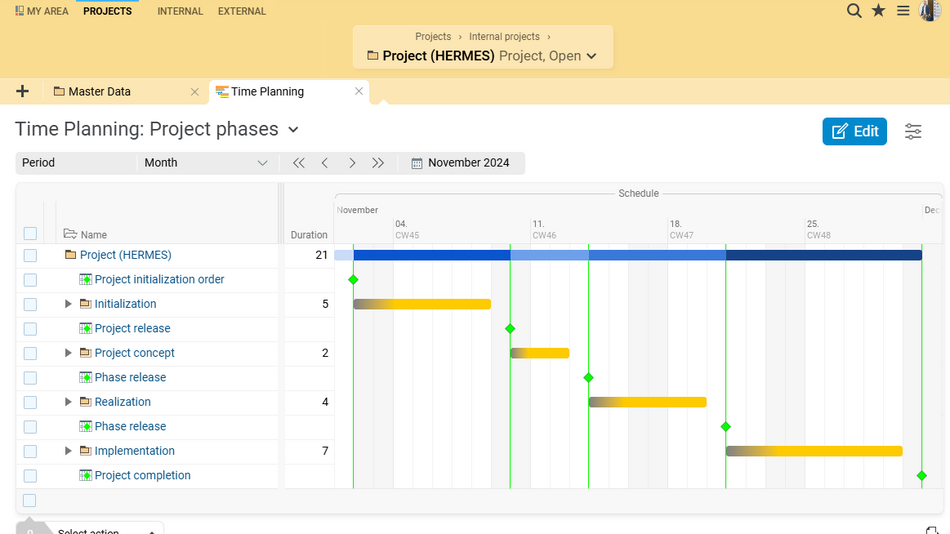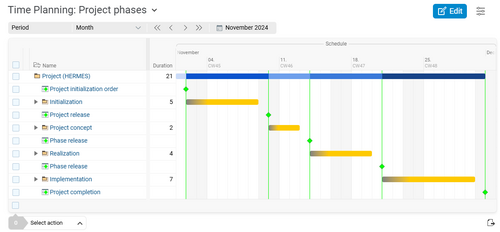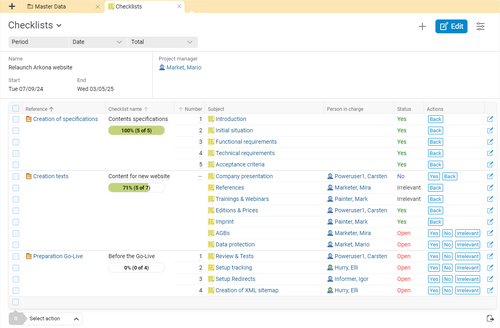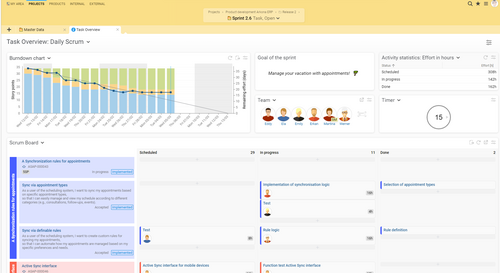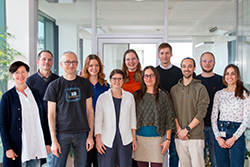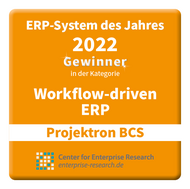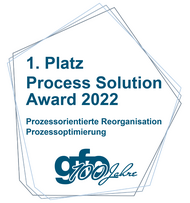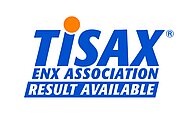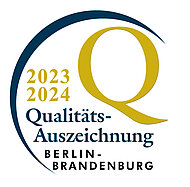HERMES
Support right from the start - flexible for every HERMES scenario
The open HERMES method is used for the uniform and structured implementation of projects in IT, communications technology, service and product development as well as corporate organization. The method has a modular structure and supports projects with varying degrees of complexity. Do you want to carry out projects according to HERMES? Projektron BCS supports you in planning, managing and working according to HERMES every step of the way. The main components of HERMES, phases, milestones, scenarios, modules, roles and tasks, are easily mapped in BCS.
Projektron BCS as versatile and flexible HERMES software
What if you had a project management software for your HERMES projects that...
➤ Flexibly adapts your projects to the different requirements of various HERMES scenarios?
➤ would make your project planning and implementation much more efficient?
➤ would display the progress of your projects transparently and clearly?
➤ effectively support you in decision-making and review processes with checklists, workflows and process modeling?
➤ would also provide you with the full range of functions of Scrum software?
➤ could map the organizational structure, roles and responsibilities in detail?

Daniel Sdiri
Administrator at Information Service Centre WBF ISCeco (Switzerland), IT service provider of the Federal Department of Economic Affairs, Education and Research (EAER)
We have been using the time recording and project functions of Projektron BCS since March 2010, the usage of which was immediately met with broad acceptance. During the project and introductory phase, we received exemplary support from the Projektron company.
HERMES project planning made easy: customizing scenarios and templates
Does your organization carry out a variety of projects that most likely differ greatly in terms of content and complexity? In order to do justice to the diversity of your projects, HERMES offers scenarios that contain the required modules. As a HERMES user, you need to be able to adapt the eight standard scenarios flexibly and easily to the needs of your organization and your respective projects or to design individual scenarios quickly and easily as required. Projektron BCS offers you precisely this flexibility.
With the help of a wizard, you can easily create templates for projects in Projektron BCS - so you can design specific scenarios for your HERMES projects in advance. When the time comes and a new project is due, you can select your customized or user-defined scenario from the templates and start the project. This saves you time in project preparation.
Once you have selected and customized the scenario, you can develop the project-specific work breakdown structure, the document templates and the checklist. You can also define easily customizable templates for these three elements in Projektron BCS. In addition to the tasks, workflows, checklists and even planning data can be stored here.
Project-specific phase plan, milestones and reports - ready for any HERMES project
Regardless of the scenario, the phase model forms the backbone of the project. HERMES projects are carried out in four phases according to a standardized phase model:
Initialization
Concept
Realization
Implementation
In the most common HERMES method, HERMES 5, there is also a fifth phase: completion. The start and end of each project phase are marked by a milestone that serves as a quality gate: the aim is to check the status of the project and the quality of project planning and implementation. There are also scenario-specific milestones.
In Projektron BCS, you not only define your project-specific project phases, you also easily define the milestones for your HERMES project as quality gates.
Thanks to the clear phase and task planning with milestones, you can see at a glance in the clear Gantt chart which phase your project is in. The milestones serve as quality gates and decision points: this is where the status of the project and the next steps are checked.
As part of project management, you benefit from the display of your project phases and milestones as an interactive Gantt chart with graphical progress display in Projektron BCS. Here you can keep an eye on all phases, milestones, modules, tasks, decisions and results centrally and are able to take action at any time.
Reporting is carried out periodically along the phases in accordance with the specifications of the parent organization in terms of content and frequency. With the reporting functions in Projektron BCS, you can adapt the standard report templates to your needs in no time at all or generate your own reports with the integrated BIRT report designer.
Workflows, checklists and processes: Decisions, approvals, quality assurance and work organization
Tasks that end with a milestone require one or more decisions. HERMES distinguishes between decisions made by the management and those made by the project management and specialists. For example, the phase release is made by the client (management), while the acceptance of the system architecture is made by an architecture manager (specialist). The decision-making tasks in HERMES are therefore supported by checklists to ensure that the necessary decisions are made and documented in the right order by the right people.
The workflows and checklists in Projektron BCS are therefore indispensable for the structured implementation of your HERMES project. With the system-controlled workflows in Projektron BCS, you can create processing sequences and response times and assign them directly to the responsible persons or placeholders. You can also use checklists to support your employees and ensure the quality of the project. You can also use defined templates here.
You can even use the integrated BPMN process designer in Projektron BCS to model decision-making processes or complex checking processes that are to be triggered on a scheduled or event-driven basis and handled automatically. BPMN (Business Process Model and Notation) is a widely used method for modelling business processes that enables standardized representation and analysis. The process generates the appropriate task or checklist for the person responsible in real time.
HERMES agile with Scrum: a good team
HERMES itself offers a module for agile development ("Entwicklung Agil“), which is included in the "Agile service/product" and "Agile individual IT application" scenarios. This agile aspect is designed using the Scrum framework.
Thanks to its simple structure and predefined roles, Scrum can be implemented quickly in Projektron BCS and ensures flexibility and transparency. BCS offers you a digital scrum board for effective daily scrums as well as a clear burndown chart for constant monitoring of sprint progress. With integrated time recording, you can quickly book and evaluate time spent on Scrum activities. Structure your product backlogs clearly with user stories and epics and track sprint metrics to keep an eye on team velocity and development effort.
Benefit from the comprehensive possibilities of Projektron BCS and combine both project management methods to seamlessly map your agile modules in HERMES.
Uniform role model and flexible organizational structures for your HERMES projects
HERMES distinguishes between roles in the core organization and roles in the project organization and defines their relationships. There is a role description for each role in the project organization. It defines the role in terms of its responsibilities, competencies and required skills.
Each role in the project organization is assigned to one of the following three hierarchy levels:
Control
management
Execution
In Projektron BCS, you define your own role model exactly as you need it for your HERMES project: With the flexible rights management in Projektron BCS, your system administrator can easily create the required roles. You then define the rights for the individual roles yourself.
Flexible organizational structures are mapped simply, individually and in detail in the Projektron BCS organization chart for HERMES projects. The different hierarchy levels in the project organization and roles of a person in the master organization and project organization can also be mapped here in detail with role descriptions.
As a HERMES project manager, you can assign both individual people and entire groups of people to your project during project planning. You can easily access the data stored in resource management and keep an eye on the workload of employees during the project. In this way, you can control the workload and ensure that the company's resources are used optimally.
Projektron BCS also enables a clear separation of resource management and project management. While the project manager plans his projects with placeholders, the line manager can assign employees accordingly.
Regardless of whether internal departments, external employees or direct assignment to the project: Projektron BCS supports you in scheduling employees on a daily basis over long periods of time. The scheduling view shows days that are already occupied so that you can quickly see which employees are scheduled and which are available. You also get an overview of multi-day appointments and potential scheduling conflicts that should be resolved immediately.
Projektron BCS as HERMES software - your benefits at a glance
Manage your HERMES projects online with Projektron BCS and benefit from the tools of professional project management software:
Comprehensive support for various HERMES scenarios and levels of complexity
Efficient adaptation of standard scenarios and project planning to the needs of your organization & projects
Transparent presentation of project progress and results through clear reporting and dashboards
Simple assignment of tasks and resources via flexible organizational structures and role models
Integration of BPMN process modeling for complex decision-making and review processes
Clear planning and monitoring of project phases and milestones with interactive Gantt charts
Supporting workflows and checklists for structured decision-making
Integration of Scrum for agile development with digital Scrum tools and time recording
Flexible role model and clear organizational structures for targeted assignment of tasks and optimal use of resources
Get to know the comprehensive and flexible functionalities of Projektron BCS for project management according to HERMES! Convince yourself of BCS as a comprehensive, open-method project management software with numerous ERP functions and start your free and non-binding test now.
